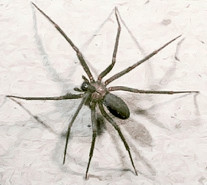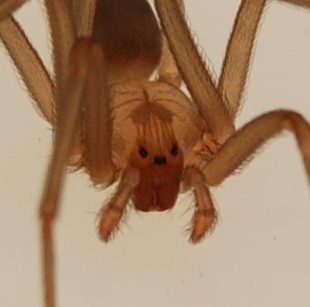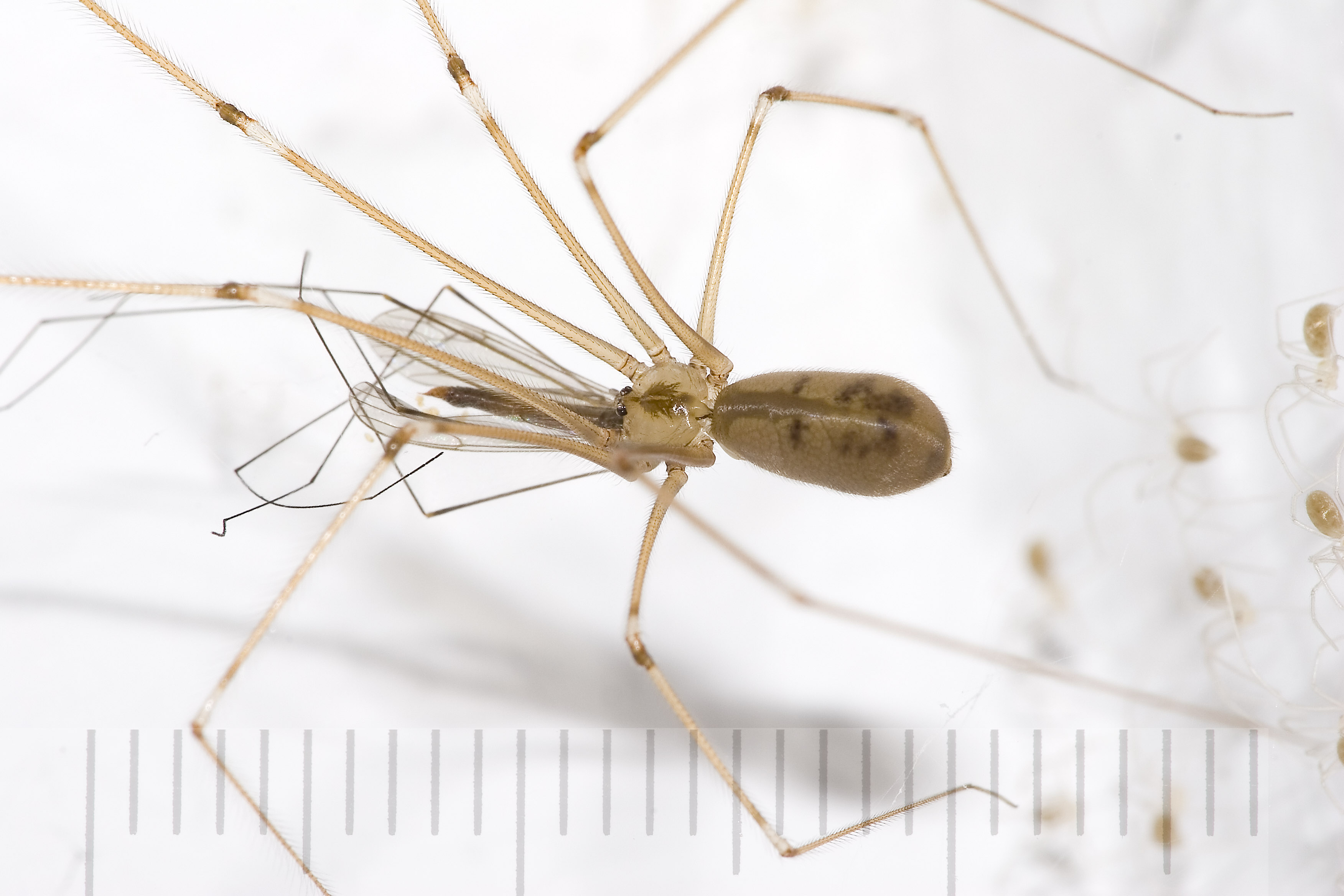|
Sicariidae
Sicariidae is a family (biology), family of six-eyed spider bite, venomous spiders known for their potentially necrotic bites. The family consists of three genus, genera and about 160 species. Well known spiders in this family include the Loxosceles reclusa, brown recluse spider and the Hexophthalma hahni, six-eyed sand spider. Description ''Loxosceles'', commonly known as "recluse spiders" or "violin spiders", are distributed nearly worldwide in warmer areas. ''Hexophthalma'' and ''Sicarius (spider), Sicarius'', commonly known as "sand spiders" or "assassin spiders", live in the deserts of southern Africa and South America, South to Central America, respectively. They are known for their self-burying behavior and the ability to go long periods without food or water. All members have six eyes arranged in three groups of two (dyads). Violin spiders are usually brownish with a darker brown characteristic violin marking on the cephalothorax. They are also haplogyne, meaning the fema ... [...More Info...] [...Related Items...] OR: [Wikipedia] [Google] [Baidu] |
Hexophthalma
''Hexophthalma'' is a genus of spiders in the family Sicariidae. Although the genus was originally erected in 1878 (then with the name ''Hexomma''), it was merged into the genus ''Sicarius (spider), Sicarius'' in the 1890s, and remained unused until revived in 2017, when it was discovered that the African species then placed in ''Sicarius'' were distinct. The English name six-eyed sand spiders is used for members of the genus, particularly ''Hexophthalma hahni''. All ''Hexophthalma'' species live in Namibia or South Africa. Species in the genus have necrosis, dermonecrotic venom, and can potentially cause serious or even life-threatening wounds. Taxonomy The genus was first created in 1878 by Friedrich Karsch as ''Hexomma'', with the sole species ''Hexophthalma hahni, Hexomma hahni''. By 1879, though, Karsch had realized that this name had already been used in 1877 for a genus of Opiliones, harvestmen, so he published the replacement name ''Hexophthalma''. In 1893, Eugène Simo ... [...More Info...] [...Related Items...] OR: [Wikipedia] [Google] [Baidu] |
Loxosceles Reclusa
The brown recluse (''Loxosceles reclusa'', Sicariidae, formerly placed in a family "Loxoscelidae") is a recluse spider with necrotic venom. Similar to those of other recluse spiders, their bites sometimes require medical attention. The brown recluse is one of two spiders in North America with dangerous venom, the other being the black widow. Brown recluse spiders are usually between , but may grow larger. While typically light to medium brown, they range in color from whitish to dark brown or blackish gray. The cephalothorax and abdomen are not necessarily the same color. These spiders usually have markings on the dorsal side of their cephalothorax, with a black line coming from it that looks like a violin with the neck of the violin pointing to the rear of the spider, resulting in the nicknames fiddleback spider, brown fiddler, or violin spider. Description The violin pattern is not a definitive identifier, as other spiders can have similar markings (e.g. cellar spiders a ... [...More Info...] [...Related Items...] OR: [Wikipedia] [Google] [Baidu] |
Loxosceles
The recluse spiders (''Loxosceles'' (), also known as brown spiders, fiddle-backs, violin spiders, and reapers, are a genus of spiders that were first described by R. T. Lowe in 1832. They are venomous spiders known for their bite, which sometimes produces a characteristic set of symptoms known as loxoscelism. Recluse spiders are now identified as members of the family Sicariidae, having formerly been placed in their own family, the Loxoscelidae. Although recluse spiders are feared, they are usually not aggressive. Relation with other spiders Sicariidae are of the superfamily Scytodoidea. Other families in the Scytodoidea include Drymusidae, Scytodidae, and Periegopidae. Habitat and appearance ''Loxosceles'' is distributed nearly worldwide in warmer areas. All have six eyes arranged in three groups of two (dyads) and some are brownish with a darker brown characteristic violin marking on the cephalothorax. However, the "violin marking" cannot be used as a reliable way to ... [...More Info...] [...Related Items...] OR: [Wikipedia] [Google] [Baidu] |
Sicarius (spider)
''Sicarius'' is a genus of recluse spiders that are potentially medically significant to humans. It is one of three genera in its family, all venomous spiders known for a bite that can induce loxoscelism. They live in deserts and arid regions of the Neotropics, and females use a mixture of sand and silk when producing egg sacs. The genus name is Latin for assassin. Description ''Sicarius'' spiders can grow up to long, and have six eyes arranged into three groups of two (known as "dyads"). Physically, they resemble crab spiders and members of the '' Homalonychus'' genus. They lack the characteristic violin-shaped marking of the more well-known members of its family Sicariidae, the recluse spiders. They can live for a very long time without food or water. Some can live for up to fifteen years, making them among the longest-lived spiders, behind the trap-door spiders and tarantulas, many known to live for twenty to thirty years. The oldest recorded spider is Number 16, a trap-d ... [...More Info...] [...Related Items...] OR: [Wikipedia] [Google] [Baidu] |
Sicarius Thomisoides
''Sicarius thomisoides'' is a species of spider in the family Sicariidae, found in Chile. It is the type species of the genus '' Sicarius''. Its correct name has been the source of confusion. It has often been known by the synonym ''Sicarius terrosus'', a name which has also often been used incorrectly for other species. Taxonomy There has been confusion over the correct name for this species. In 1847, Charles Athanase Walckenaer published the name ''Sicarius thomisoides'', also erecting the genus '' Sicarius''. He based the name on illustrations he had seen in a work still in preparation and so not then published, namely a section on spiders by Hercule Nicolet in the multivolume ''Historia física y política de Chile''. It was finally published in 1849. Nicolet called the species ''Thomisoides terrosus''. In his earlier publication, Walckenaer had argued that ''Thomisoides'' was inappropriate as a genus name, as the species was not related to '' Thomisus'', a crab spider. Althou ... [...More Info...] [...Related Items...] OR: [Wikipedia] [Google] [Baidu] |
Sicarius Ornatus
''Sicarius ornatus'' is a species of venomous spider found in South America (Brazil). It has a highly toxic venom like the other South American sicariid, '' Loxosceles laeta'' and the African '' Hexophthalma hahni'', but there are few human bites recorded. Its venom has active sphingomyelinase D, and can lead to a severe pathology. The venom of ''Sicarius ornatus'' contains active sphingomyelinase D, the main toxin responsible for local and systemic effects, the venom of ''S. ornatus'' is endowed with all toxic properties in vitro and ex vivo, and like ''Loxosceles'', it is capable and hydrolyzes sphingomyelin , induce cell death of keratinocytes and complement-dependent hemolysis Hemolysis or haemolysis (), also known by #Nomenclature, several other names, is the rupturing (lysis) of red blood cells (erythrocytes) and the release of their contents (cytoplasm) into surrounding fluid (e.g. blood plasma). Hemolysis may ..., harmful events that have been associated with the ... [...More Info...] [...Related Items...] OR: [Wikipedia] [Google] [Baidu] |
Hexophthalma Hahni
''Hexophthalma hahni'' (synonyms ''Sicarius hahni'' and ''Sicarius testaceus''), known along with other members of the genus as the six-eyed sand spider, is a member of the family Sicariidae, found in deserts and other sandy places in southern Africa. Due to their flattened stance and laterigrade legs, they are also sometimes known as six-eyed crab spiders. Its specific name honours Carl Wilhelm Hahn. Venom All species of ''Hexophthalma'' produce venom that can have dermonecrotic effects, capable of causing serious or even life-threatening wounds, particularly if the wound becomes infected or the venom spreads in the body. The necrotic effects are caused by a family of proteins related to sphingomyelinase D Sphingomyelin phosphodiesterase D (EC 3.1.4.41, sphingomyelinase D) is an enzyme of the sphingomyelin phosphodiesterase family with systematic name sphingomyelin ceramide-phosphohydrolase. These enzymes catalyse the hydrolysis of sphingomyelin, r ..., present in the venom ... [...More Info...] [...Related Items...] OR: [Wikipedia] [Google] [Baidu] |
Loxosceles Laeta
The Chilean recluse spider, ''Loxosceles laeta'', is a highly venomous spider of the family Sicariidae. In Spanish, it (and other South American recluse spiders) is known as ', or "corner spider"; in Brazilian Portuguese, as ' or "brown spider". It is considered by many to be the most dangerous of recluse spiders, and its bites often result in serious systemic reactions, up to and including death. Description The Chilean recluse is one of the larger species of recluse spiders, generally ranging from 8–40 mm in size (including legs). Like most recluses, it is brown and usually has markings on the dorsal side of its thorax, with a black line coming from it that looks like a violin with the neck of the violin pointing to the rear of the spider resulting in the nickname "fiddleback spider" or "violin spider" in English-speaking areas. Coloring varies from light tan to brown and the violin marking may not be visible. Since the "violin pattern" is not diagnostic, it is far mo ... [...More Info...] [...Related Items...] OR: [Wikipedia] [Google] [Baidu] |
Sicarius Tropicus
''Sicarius tropicus'' is a species of six-eyed sand spider ('' Sicarius'') endemic in South American caatinga in Brazil. Like related spiders, it is venomous, but only one medically-significant bite has been recorded, causing dermonecrotic lesions in a 17-year-old boy. Venom A 2021 study compared the venom with that of ''Loxosceles laeta'', considered the most toxic species in the genus. The venom of ''S. tropicus'' contains Sphingomyelinase D, capable of causing dependent ''hemolysis Hemolysis or haemolysis (), also known by #Nomenclature, several other names, is the rupturing (lysis) of red blood cells (erythrocytes) and the release of their contents (cytoplasm) into surrounding fluid (e.g. blood plasma). Hemolysis may ...''; the hemolysis mechanisms were found to differ between the two species. References {{Taxonbar, from=Q2401348 Sicariidae Spiders described in 1936 Spiders of Brazil ... [...More Info...] [...Related Items...] OR: [Wikipedia] [Google] [Baidu] |
Thomisidae
The Thomisidae are a family of spiders, including about 170 genera and over 2,100 species. The common name crab spider is often linked to species in this family, but is also applied loosely to many other families of spiders. Many members of this family are also known as flower spiders or flower crab spiders. Description Members of this family of spiders do not spin webs, and are ambush predators. The two front legs are usually longer and more robust than the rest of the legs. The back two legs are smaller, and are usually covered in a series of strong spines. They have dull colorations such as brown, grey, or very bright green, pink, white or yellow. They gain their name from the shape of their body, and they usually move sideways or backwards. These spiders are quite easy to identify and can very rarely be confused with Sparassidae family, though the crab spiders are usually smaller. Etymology Spiders in this family are called "crab spiders" due to their resemblance to cr ... [...More Info...] [...Related Items...] OR: [Wikipedia] [Google] [Baidu] |
Haplogyne
The Haplogynae or haplogynes are one of the two main groups into which araneomorph spiders have traditionally been divided, the other being the Entelegynae. Morphological phylogenetic studies suggested that the Haplogynae formed a clade; more recent molecular phylogenetic studies refute this, although many of the ecribellate haplogynes do appear to form a clade, Synspermiata. Unlike the Entelegynae, haplogynes lack hardened (sclerotized) female genitalia (epigynes). Most of the species within this group have six eyes, as opposed to most other spiders. Spiders in the genus '' Tetrablemma'' ( Tetrablemmidae) have only four eyes, as do some members of the family Caponiidae; caponiids may even have only two eyes. However, spiders in the family Plectreuridae have the normal eight eyes. Phylogeny The Haplogynae are one of the two major groups into which araneomorph spiders were traditionally divided, the other being the Entelegynae. In 2005, Coddington summarized the relationship ... [...More Info...] [...Related Items...] OR: [Wikipedia] [Google] [Baidu] |
Spider Bite
A spider bite, also known as arachnidism, is an injury resulting from the bite of a spider. The effects of most bites are not serious. Most bites result in mild symptoms around the area of the bite. Rarely they may produce a necrotic skin wound or severe pain. Most spiders do not cause bites that are of importance. For a bite to be significant, substantial envenomation is required. Bites from the Latrodectus, widow spiders involve a neurotoxic venom which produces a condition known as latrodectism. Symptoms may include pain which may be at the bite or involve the chest and abdomen, sweating, muscle cramps and vomiting among others. Bites from the recluse spiders cause the condition loxoscelism, in which local necrosis of the surrounding skin and widespread hemolysis, breakdown of red blood cells may occur. Headaches, vomiting and a mild fever may also occur. Other spiders that can cause significant bites include the Australian funnel-web spider and Phoneutria fera, South Ameri ... [...More Info...] [...Related Items...] OR: [Wikipedia] [Google] [Baidu] |





